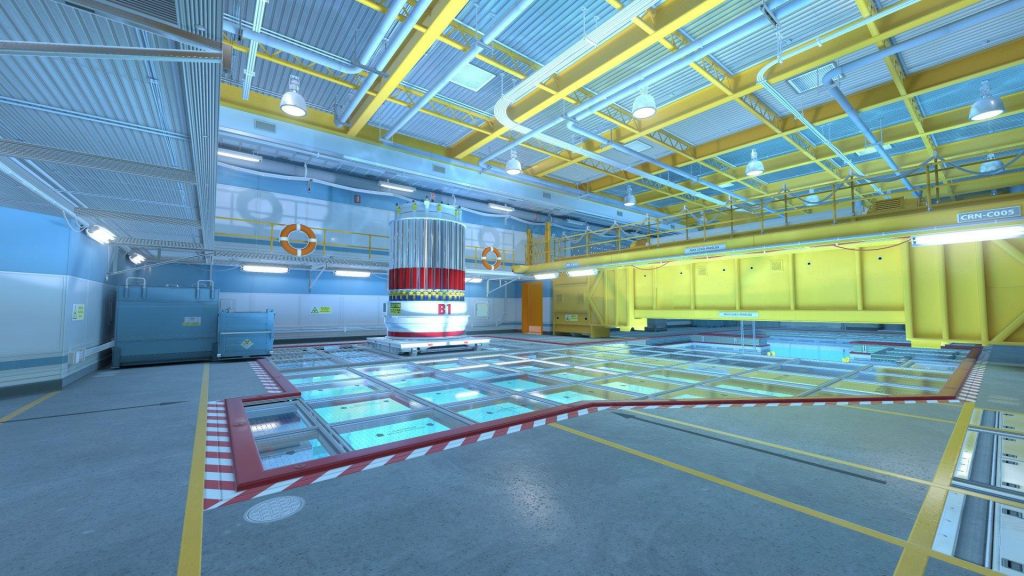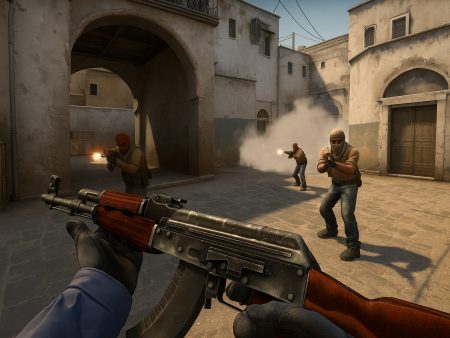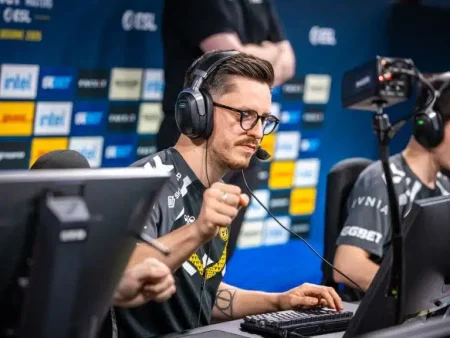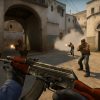Master CS2’s most complex map with this complete Nuke guide. Learn essential callouts, pro strategies, CT/T setups, utility tips, and rotation tactics to dominate your matches.
Nuke isn’t just a map—it’s a mental gym for any CS2 player. It’s where strategy trumps brute force, and where verticality meets paranoia. The complexity of Nuke stems from its three-dimensional design. Unlike Dust2 or Mirage, where everything feels linear and “flat,” Nuke introduces height, layers, and countless hidey-holes that give defenders huge advantages—unless you know what you’re doing.
Every angle on Nuke has a counter-angle. You’ve got players dropping through vents, flanking from heaven, or sneaking through secret tunnels. It’s not unusual to be holding one site, hear a footstep above you, only to be shot from below seconds later. This multi-level madness demands superior communication, an excellent understanding of timing, and a thorough knowledge of every callout and rotation possibility.
Additionally, Nuke favors the CT side significantly. In most matches, you’ll see CT teams rack up 9-10 rounds before the switch. For T sides, it becomes a test of patience and precision. That imbalance makes Nuke incredibly punishing for uncoordinated teams but deeply rewarding for those who prepare.
Mastering Nuke isn’t just about aim—it’s about brains. And if you want to be a brainiac on this map, you better know every nook and cranny, which is exactly what this guide is here for.
What Makes Nuke Unique in CS2 Competitive Play

Nuke stands alone in CS2 for a couple of reasons. First, it’s the only map where the A and B sites are stacked vertically rather than being spread out horizontally. That changes everything about how you rotate, defend, and attack. Vents, ladders, and ramps become critical parts of the gameplay, and quick shifts between levels can make or break a round.
Secondly, Nuke has a strong emphasis on sound cues. Dropping into vents, opening squeaky doors, running through radio or secret—these all create audible clues. Good players abuse this to fake, mislead, or bait rotations. Nuke isn’t just a shooter’s map—it’s a tactician’s playground.
And then there’s the outside area—massive, open, and key to most strategies. This part of the map is like a chessboard. Controlling outside means controlling the game. If Ts can sneak through secret undetected, they can collapse on B site from below. If CTs dominate outside with AWPers or well-placed smokes, they choke off the T side entirely.
Add to that tight chokepoints like hut, squeaky, and ramp, and you’ve got a map where small mistakes are fatal. Nuke rewards structure, not solo play. Teams who dominate on Nuke understand timing, utility usage, and above all—how to communicate.
Understanding Nuke Map Layout

Overview of Upper and Lower Sites
Let’s get the basics out of the way. Nuke has two bombsites: A (upper site) and B (lower site). But unlike most maps where sites are side-by-side, on Nuke, these sites are stacked. Literally. The A site sits above the B site, connected by two main paths: the vent system and a long underground route from secret.
A Site (Upper):
- Located directly above B.
- Accessible via squeaky door, hut (from lobby), heaven, and vents.
- Key defensive positions include heaven, rafters, floor behind silos, and mini.
B Site (Lower):
- Harder to access for Ts.
- Usually entered via vents or the long route from secret/outside.
- Key defensive positions include double doors, control room, dark spot, and single door.
Rotations between the two sites can be lightning fast if you’re a CT. You drop into the vent from A to get to B, or vice versa through secret and ladder room. This vertical flexibility is why CTs love Nuke—it allows fast site support with minimal exposure.
Key Verticality and Multi-Level Design Elements
What truly sets Nuke apart from other CS2 maps is its verticality. While other maps have staircases and maybe an elevated area or two, Nuke is like a five-story building with overlapping fields of fire. Let’s break down why this matters:
- Crosshair Placement Gets Harder:
On Nuke, you’re not just watching angles at eye level. You’re watching up ladders, down ramps, across catwalks, and sometimes through holes in the floor. - Sound Confusion:
Is that footstep above you? Below? Right next to you? Players often second-guess what they hear on Nuke because sound travels weirdly between floors. Good players exploit this by fake-dropping or walking instead of running. - Rotations Are Tricky:
CTs can rotate fast via vents or heaven, but those routes are also risky. If a T hears a vent drop, that player’s position is compromised. Similarly, heaven rotates expose CTs to lobby pushes. - Angles and Coverage:
The overlapping levels mean you can often see players before they see you—especially from heaven to site or rafters. That makes holding angles and peeking extremely timing-dependent.
If you don’t understand this layered layout, you’ll find yourself dying to enemies you didn’t even know could see you.
Essential Callouts on Nuke
Upper Bombsite (A Site) Callouts
Nuke’s A Site has more callouts than you’d expect. Here’s a breakdown of the must-know locations on A:
- Silo – The big red vertical tank in the middle of A site. Players often jump on top to hold or peek.
- Mini – The CT entrance to A site from outside.
- Hut – The doorway from lobby to A.
- Squeaky – The small door next to hut, often molly’d or nade-stacked.
- Heaven – Elevated area above A site, accessible from ladder room. Great for defending and post-plants.
- Rafters – Horizontal metal beams running across A. High-skill players use these for tricky angles.
- Floor – Refers to playing on the ground near the site box or behind silo.
- Vents – Drop point from A to B.
These callouts are the backbone of coordination. If someone says “one rafters,” that tells you to pre-aim up high. “One squeaky” means prepare for a door push. Without these terms, you’re playing blind.
CT Side Strategies on Nuke
Standard CT Setup
When you’re defending on CT side, the goal is to exert map control without overextending. A balanced setup usually looks like:
- One player in Outside / Yard (or “mini”), using smokes and vision to contest secret or outside pushes.
- Two players on A site, one holding from heaven or rafters, the other watching hut/squeaky/floor.
- Two players on B site, often one in control room and the other near double doors or vents.
This formation gives flexibility. If Ts push A, you already have presence from heaven and hut. If Ts go B, players in control room can stall, and vent drop can be met by the B player or rotated help.
In many rounds the Outside or mini player will throw a early smoke or molly, maybe delay a push, then fall back to assist A or rotate if necessary. The idea is to contest space early, but never overcommit too far from your site.
Key in the standard setup is ensuring information control. The CTs should always know or suspect whether Ts have control of secret, ramp, or yard. Use infrequent peek timings, utility, and crossfires so nothing comes as a surprise.
Aggressive CT Plays
While the standard setup is solid, a coordinated CT team can benefit from occasional aggression—especially on Nuke. Here are some aggressive CT tactics to throw Ts off balance:
- Outside pressure push: Two CTs go deep into yard/secret early to contest and possibly kill Ts trying to take outside. It’s risky, but if done with timing (e.g. early round, before Ts set up utility), it can shut down T plans before they even start.
- Ramp or lower peek: A CT from B site can push a little forward or peek lower ramp. The goal is to catch Ts walking into site or to trade early kills. But this is dangerous—Ts often stack utility here, so use flash support or smoke cover.
- Aggressive heaven control: Instead of passively holding heaven, some CTs push ladder room or try to anchor more forward in rafters or behind cover. This can give early picks but also leaves you exposed if Ts have strong smokes/flash combo.
- Fake rotates or isolation fights: Send one or two CTs deep to make it look like a rotation is happening. If Ts believe the fake, they might commit to the opposite site, leaving themselves vulnerable.
Aggression on Nuke must be selective. Once Ts have map control or utility up, it often becomes suicidal to overextend.
How to Control Outside Efficiently
Outside (yard / secret) is ground zero for many Nuke rounds. Controlling it gives Ts options; losing it often means being hemmed in. Here’s how CTs can be smart about controlling this space:
- Smoke and Molotov Coordination
Early smokes like “Red to Secret,” “Window to Secret,” “Lower Yard” are staples. Molotovs can block off secret push paths or deny Ts from pacing through yard doors. - Spawn or mid peeks at proper times
A CT may peek yard or secret at round start to apply pressure or force Ts to slow utility. But these peeks must be timed so you don’t get caught in utility or traded easily. - Crossfire setups with multiple angles
One CT watches secret door, another watches yard from mini or hut. When Ts try to push, you want overlapping sightlines, so Ts can’t blind your teammates without exposure. - Rotate support properly
If Ts commit to an outside-driven B split, the CT outside player should be ready to fall back or play crossfires, while the A/Upper team helps from heaven, vents, or ladder room. The goal is to delay and get kills, not necessarily win the outside fight outright. - Use utility to deny info
Smokes or flashes that block Ts from seeing inside or seeing your nest of defenders can be game-changers. One well-placed smoke can force Ts to guess and delay their push.
T Side Strategies on Nuke
Default T-Side Control
As T, your first goal is map control and probing CT defenses, not full-committing blind. A good default T side often involves:
- Outside/Secret presence
Send one or two Ts to take control of outside yard and secret. Use smokes and flashes to slowly inch forward and deny CT vision. - Ramp pressure
One or two Ts press ramp to force CTs in B to respond. Prevents CTs from freely holding aggressive positions. - Connect CT rotation paths
Having presence in lobby, main, or hut to monitor CT rotations (e.g. peek ramp, squeaky) is key. Even if you don’t push immediately, just showing presence forces CTs to watch. - Mid control
Some Ts peek from ramp into vents or vents into B to see if CTs are guarding vents. This gives information and can open the B path.
The “default” is slow, methodical, controlling lines, gathering info, exhausting CT options before you commit.
How to Execute A Site
Getting into A is tricky due to vertical angles, heaven control, and hut defenders. Here’s a reliable approach:
- Outside pressure & secret as a fake or real threat
If CTs commit heavily to B, a strong outside push or secret pressure can thin their A defense. Even if it’s a fake, it forces utility usage or rotations. - Smokes for hut, squeaky, heaven, rafters
Key smokes include blocking CT’s line from heaven to site, hut entry, and rafters. With well-timed flashes, you blind heaven or hut defenders. - Stack utility in site entry
Use molotovs on rafters, push CTs out from behind boxes or silo, and combine flashes from multiple angles to blind defenders. - Tradeable angles & crossfires
Once you’re in site, Ts should set up crossfires: one holds mini or floor, another watches hut or squeaky. Don’t all peek the same angle—spread out to avoid being traded poorly. - Post-plant placements
After the plant, send one T to hold from silo or floor, another to heaven or rafters if possible, the rest on mini or hut. Control vents or drop points to discourage CT rotation.
The trick is to collapse all utility-heavy zones at once, overwhelm what remains of A’s defense, and then lock down post-plant positions.
How to Execute B Site via Ramp or Secret
B is naturally harder to take, but the secret/vent routes give you options. Here’s how to approach it:
Via Ramp (Lower Path):
- Use early smokes to cover double doors, control room, and vent exit zones.
- Send a few players through ramp, while some go through secret/vents to pinch B defenders.
- One or two Ts can lurk the vent drop into B, catching CTs trying to retake or rotate.
Via Secret + Vent Drop (Upper to Lower):
- Ts take control of secret and push into the ladder room or close vent.
- Then drop into B from vents. Use utility to cover vent drop zone so CTs can’t pre-aim or flash you easily.
- At the same time, send Ts through ramp to execute a two-pronged B push. The split forces CTs to split their attention.
Utility must be synchronized. Good flash coverage over double doors and control room is essential. Molotovs help deny CTs holding in tight corners or behind boxes.
After plant, hold from inside the site (dark, double, forward), and keep a player in vent drop path or on secret to delay rotation.
Best Smokes, Flashes, and Nades on Nuke
Outside Smokes (Red to Secret, Wall of Smokes)
Outside is a critical battleground, and the right smokes can control the pace of the round. Here are classic smokes:
- Red to Secret: Blocks CT vision from outside into secret pathway.
- Windows to Secret / Lower Yard: Obscures CT’s ability to peek from mini or windows.
- Wall-of-smoke techniques: Using multiple smokes in a wall formation to block broad vision—this is especially useful when pushing outside or transitioning between outside and yard.
Timing matters—if you smoke too early, CTs might push through. Too late, and CTs already have vision.
Site Entry Flashes and Molly Spots
When entering A or B, utility is your key tool. Recommended usages:
- Flashes
- Pop-flashes toward heaven or rufts/rafters so defenders can’t pre-aim easily.
- Backline flashes for CTs holding site deep.
- Flash over huts or through squeaky to blind defenders.
- Molotovs / HE grenades
- Flush out rafters, silo, or behind boxes.
- Deny jumps onto silo or higher angles.
- HE grenades into tight spaces (behind boxes, dark corners) can chip health or cause movement.
Utility to Deny CT Info or Rotations
You can disrupt CT rotations or prevent them from getting information. Some tactics:
- Molotovs placed in vents or ladder room, preventing CTs from safely using those paths.
- Smokes to block off rotational doors or cross paths.
- Flashing over main paths at rotation times to blind defenders moving between sites.
- Delayed smokes: hold off until CTs begin to rotate, then deploy smokes to block their path or vision, forcing awkward movement or timing.
Nuke Economy Management Tips
Buying Smart on CT and T Sides
Nuke is unforgiving—bad buys can cost rounds. Here’s how to manage:
CT Side:
- Early rounds: prioritize utility (smokes, molotovs) over weapons. Half-buy if needed.
- Middle rounds: full buy with utility is standard—never skimp on smoke because outside control is vital.
- If low economy: buy UMPs, CZs, or SMGs but keep one smoke or molly. That one utility can stall T pushes.
T Side:
- You need utility, but your guns need backup. On eco rounds, focus on cheap smokes, HE grenades.
- Force rounds: prioritize weapons over armor if you’re going aggressive with utility support.
- If Ts have good economy, bring multiple smokes and flashes—even over a rifle if it means executing a site more reliably.
- Don’t just stack weapons; invest in utility to cripple CT defenses.
When to Force or Eco Based on Round Win Probability
- After CT side win streaks: If CTs have 4–5 rounds in a row, T side often must force or partial. Even losing the round might force CTs to adjust.
- On CT side: if you lose a few in a row and can’t afford full buys, half-buy to stay competitive. Don’t walk in with nothing.
- Bluff or surprise force when opponents expect an eco—switch up and rush with utility to catch CT unprepared.
Positioning and Crosshair Placement
How to Master Multi-Level Angles
Crosshair placement on Nuke is less about level with the floor—you must always think vertical. Tips:
- Pre-aim common head level at high angles (rafters, heaven, vent drop). Don’t aim too low.
- When going up ladder or ramp, adjust crosshair upward early.
- Use horizontal crosshair placement (sliding left-right) to track multi-level entry points (e.g. someone vent dropping while another pushes ramp).
- After using utility or forcing angles open, reposition crosshair to where enemies will come out, not where they are now.
High-Impact CT and T Positions
Some positions give disproportionate influence:
- Heaven (CT): Overlooks A, helps rotations, can see ramps or crossfires.
- Rafters (T or CT): Gives height to peek down into site or sneak peeks.
- Vents (T): From secret to B or drop to B—being in control of vents means surprise potential.
- Silo / Floor (T post-plant): Good cover, angles to block rotations, and safe crossfire potential.
Avoid staying in static positions for too long; Ts and CTs will pre-nade or pre-flash those positions. Always be ready to swap or rotate.
Pro-Level Tips and Tricks on Nuke
Secret Control Like a Pro
Secret is the main artery leading from Outside to B site. If Ts gain control of Secret, they unlock access to the most vulnerable point of the CT defense. But holding or contesting Secret takes more than just walking down the stairs. Here’s how the pros do it:
For CTs:
- Early Molotovs and Smokes: Pro CTs often molly the Secret stairs or deploy outside smokes to block Ts from getting a clear path. This delays the push or forces Ts to waste utility.
- AWP Angles from Garage: Many top AWPers hold a pixel angle from Garage onto the Secret cross. It’s a tough shot but highly rewarding—catching Ts as they cross into danger.
- Secret Stack: Occasionally, CTs will place a rifler down in Secret with an SMG or M4, holding a passive angle. If the Ts push blindly, it’s a free kill or two.
For Ts:
- Wall of Smokes: The “wall of smokes” is the standard strat. Ts throw 3-4 smokes to cover Garage, Red, and Secret path—completely blocking vision from Mini and Heaven.
- One-Way Smokes: Some pros drop a smoke at the Secret entrance with a slight gap, allowing them to see CTs pushing through but remaining unseen.
- Split Pushes: Combine a push from Secret with one from Ramp or Vents. This divides CT focus and increases your odds of a successful B-take.
Taking Secret without losing players is a skill that separates good teams from great ones. You need tight utility usage, perfect timing, and map awareness to pull it off consistently.
Vents and Heaven Rotations Timing
The true power of Nuke lies in how fast and flexible rotations can be—if timed well. Pro players excel at vent drops and heaven transitions without giving away info. Here’s how they do it:
CT Rotations:
- Silent Drop to B from Vents: If you crouch-drop and use the right angles, you can silently rotate to B. This is crucial if you want to reinforce B without alerting the Ts.
- Heaven to A via Ladder Room: This rotation allows fast support of A site without exposing yourself from Lobby or Mini.
- Fake Rotates: CTs will occasionally fake a rotate sound (vent drop or heaven ladder noise) to bait Ts into overcommitting or rushing a site.
T Side Tricks:
- Fast Vent Dive: Some Ts throw an instant door molly and follow it with a vent dive. This often catches the CTs off-guard—especially if done early in the round.
- Late Vent Split: While the round plays out slowly, a T silently sneaks down vents while others take Heaven or Ramp. This late round squeeze overwhelms even experienced defenders.
Timing here is everything. Misjudge your rotate by a second, and you’re running into a stacked defense. But time it perfectly, and you catch your opponents with their pants down.
Team Communication and Coordination
Using Callouts Effectively in Team Play
It’s one thing to know the callouts on Nuke. It’s another to use them effectively in live play. Callouts should be concise, accurate, and timely. Here’s how to level up your team comms:
- Be Specific, Not Vague: Instead of saying “one on A,” say “one rafters, one heaven.”
- Time Your Info: If you call a player’s position but they move 5 seconds later, your info is outdated. Always clarify if the enemy is still there or has moved.
- Stacked Info: Combine enemy location with condition. For example: “One outside, no armor,” or “Two pushing ramp with full utility.”
- Chain Calls: If your teammate dies and calls “one squeaky,” the next player should immediately respond with “holding mini,” “flashing hut,” or “rotating heaven.”
Communication on Nuke is everything. With so many vertical and hidden areas, one miscommunication can lead to site loss or a team wipe. Practice clear, rapid-fire callouts until they’re second nature.
How to React to Fast Executes or Fakes
Nuke is full of fast executes and deceptive plays. Your team must learn how to recognize and respond to both.
If You’re Defending Against a Fast Execute:
- Don’t Panic Rotate: Ts love to bait a full stack onto the wrong site. Wait for solid confirmation (bomb drop, full push sounds) before abandoning your post.
- Pre-Nade Entry Points: If you hear door rush or vent dive, pre-molly the entrance or throw a nade to chip damage and delay.
- Crossfire Positions: Fast pushes are neutralized by crossfires. If Ts enter A, one CT should hold heaven while another plays under silo or hut.
If It’s a Fake:
- Hold Utility: Don’t waste all your nades on a sound cue. Wait until you see players commit before using molotovs or flashes.
- Communicate Intelligently: Say “I think it’s a fake; I didn’t hear steps after flashes.” This can save your team from unnecessary rotations.
Smart teams use audio cues, slow walks, and delayed pushes to bait you. Stay calm, call info clearly, and trust your teammates.
Common Mistakes Players Make on Nuke
Poor Usage of Utility
Nuke is one of the few maps where your smokes, flashes, and mollies can literally win or lose the round before any shots are fired. Here’s where most players go wrong:
- Wasting Outside Smokes: Many Ts toss their wall smokes too early, allowing CTs to counter-smoke or push through after the fade. Timing is key.
- Flashing Teammates: Nothing worse than a pop-flash into hut only to blind your own entry fragger. Know your angles and communicate before you toss.
- No Post-Plant Utility: Save at least one molotov or smoke for the post-plant. It’s vital for blocking off retake paths or delaying defuse.
Utility on Nuke is less about damage and more about map control. A single molotov on Heaven or a smoke in Vents can shift the entire round.
Bad Rotations and Overcommits
Rotations on Nuke can be fast—but they can also be fatal if you mistime them. Common errors include:
- Leaving Sites Too Early: Hearing one footstep outside doesn’t mean an A hit is off the table. Many teams fake outside to draw off defenders.
- Overstacking B Site: Secret pushes are common, but don’t send 3 players B unless you’ve confirmed a full commit.
- Not Watching Vent Drops: If you leave vents open, Ts will use them. Always assign someone to either watch or booby-trap the vents.
Fixing these mistakes can instantly boost your team’s CT hold percentage.
How to Practice and Improve on Nuke
Best Workshop Maps for Practice
Improving on Nuke requires more than matchmaking. Use these CS2/CS:GO workshop maps to sharpen your skills:
- Yprac Nuke Guide Map: The gold standard. Practice smokes, flashes, and all utility with guided visuals and bots.
- Aim Botz – Training: Focuses on aim and muscle memory. Perfect for snapping to Heaven, Silo, and Secret angles.
- Recoil Master – Spray Training: Learn to control recoil patterns, essential for tight A site and Ramp duels.
- Crosshair Placement Maps: Teaches proper crosshair positioning for vertical fights—something Nuke has in abundance.
Spend 20–30 minutes daily in these maps, and you’ll see rapid improvement.
Scrimming and Reviewing Demos
Play with a 5-stack and scrim against other teams. Nuke demands coordination—you won’t learn much solo queuing. After every game:
- Review POV Demos: Watch from your own perspective. Did you rotate too early? Miss a smoke?
- Watch Pro Matches: Learn how top teams like NAVI, FaZe, or Vitality play Nuke. Study their default setups and utility usage.
- Record Comms: Listen to how well your team communicates. Trim down the chaos and keep comms clear and efficient.
Nothing beats hands-on experience followed by critical analysis.
Nuke in Competitive Meta
Why Top Teams Prioritize Nuke
Despite its complexity, Nuke is often a pick for top-tier teams. Why? Because it rewards preparation and punishes chaos. Here’s why teams love it:
- CT Side Dominance: Good teams can rack up 10+ rounds on CT, putting massive pressure on opponents.
- Rotational Depth: Teams with excellent communication thrive on Nuke thanks to quick rotates and crossfire setups.
- Utility-Heavy Playstyle: Squads with clean execs and smoke lineups (like Astralis or Vitality) dominate this map.
- Information Warfare: Teams that excel at reading fakes and rotating smart can control Nuke without even needing frags.
Current Trends and Strategies in Pro Play
Recent trends show a shift toward:
- Aggressive Yard Control by CTs: Pro teams like G2 are pushing outside early to deny T space.
- Ramp-to-Secret B Hits: Combining pressure from multiple angles into B has become meta.
- Heaven and Rafters Post-Plants: Instead of playing site, Ts now often retreat to higher ground for better post-plant vision and cover.
As CS2 continues to evolve, Nuke remains a centerpiece of tactical play. If you want to compete, mastering this map is essential.
Conclusion
Nuke isn’t just another map in CS2—it’s a test of your team’s coordination, strategy, and grit. From the maze-like callouts to the multi-level chaos of combat, Nuke forces players to think two steps ahead and execute with surgical precision.
If you’re serious about improving, take this guide to heart. Learn the callouts. Practice the utility. Time your rotates. Communicate like a pro. And most importantly—don’t get discouraged. Nuke has a steep learning curve, but once you climb it, you’ll dominate.
FAQs
What’s the hardest part of learning Nuke?
Understanding rotations and vertical angles. The map’s design makes it easy to get lost or caught off guard without map knowledge.
How can I improve my Outside control on T side?
Use coordinated wall smokes and pressure from Lobby or Silo. Time your pushes to counter CT peeks, and send lurkers through secret.
Are there specific agents or skins best for visibility on Nuke?
Yes, lighter agent skins can blend in with the light-gray environment. Stick with default agents or pick high-contrast ones for visibility.
What’s the best way to stop a vent dive?
Pre-molotov Squeaky or vent entrance at round start. Hold crosshairs at head-level if you expect a fast drop.
How do I train my crosshair placement for multi-level fights?
Use workshop maps and deathmatch to practice vertical pre-aiming. Focus on angles like Heaven, Rafters, and Ramp.











